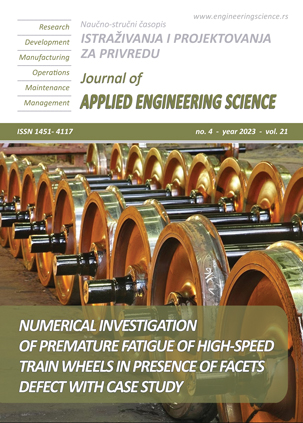ANALYSIS OF FACTORS INFLUENCING THE PERFORMANCE OF CADETS TRAINED TO OPERATE LOGGING MACHINERY
Abstract
The paper analyzes factors that affect human productivity when operating logging machinery. It assesses how training machines and simulators influence the results of training. The paper further describes novel methods for testing the psychophysiological traits of human beings that enable evaluating the precision of guiding the implement of the logging machine in horizontal plane as well as by boom extension. The results of testing a group of cadets are presented herein. The research team found the boundaries of the test results obtained by the author-developed methods as compared against the results of final examinations held to complete the logging machinery operation training. The paper will be of interest for human- machine interaction and logging machine training specialists.
References
Chernykh, D., Steshina, L., Petukhov, I., Andrianov, Y., & Velev, D. (2023). The approach to training logging machinery operators. Journal of Applied Engineering Science, vol. 21, no. 1, 70-75. https://doi.org/10.5937/jaes0-38214
Ortiz Morales, D., Westerberg, S., La Hera, P.X., Mettin, U., Freidovich, L. and Shiriaev, A.S. (2014), Increasing the Level of Automation in the Forestry Logging Process with Crane Trajectory Planning and Control. J. Field Robotics, vol. 31, 343-363. https://doi.org/10.1002/rob.21496
Kariniemi, A. (2006) Kuljettajakeskeisen hakkuukonetyön malli – työn suorituksen kognitiivinen tarkastelu (Operator-specific model for mechanical harvesting – cognitive approach to work performance). Helsingin yliopiston metsävarojen käytön laitoksen julkaisuja. Yliopistopaino, Helsinki, 126 p.
Shemakin, Yu.I. (2007). Systemantics of Cognition (Sistemantika poznaniya). Bulletin of the Russian Academy of Natural Sciences, iss. 3, 69-73.
Antonya, C., Butnariu, S. (2022). Preservation of Cultural Heritage Using Virtual Reality Technologies and Haptic Feedback: A Prototype and Case Study on Antique Carpentry Tools, Applied Sciences, vol. 12(16), 8002. https://doi.org/10.3390/app12168002
Steshina, L., Petukhov, I., Glazyrin, A., Zlateva, P., Velev, D. (2020). An Intelligent Virtual Environment for Training with Dynamic Parameters. ACM International Conference Proceeding Series, 79–84. https://doi.org/10.1145/3442705.3442718
Wallhoff, F., Ablassmeier, M., Bannat, A., Buchta, S., Rauschert, A., Rigoll, G., Wiesbeck, M. (2007). Adaptive human-machine interfaces in cognitive production environments. ICME 2007, Beijing, 2246-2249. https://doi.org/10.1109/ICME.2007.4285133
Riviere, C. N., Thakor, N. V. (1995). Adaptive human-machine interface for persons with tremor. Proceedings of 17th International Conference of the Engineering in Medicine and Biology Society, vol. 2, 1193-1194. https://doi.org/10.1109/IEMBS.1995.579637
Ovaskainen H. (2005). Comparison of harvester work in forest and simulator environments, Silva fennica, vol. 39, no. 1, 89-101. https://doi.org/10.14214/sf.398
Burk, E., Han, H. S., Smidt, M., Fox, B. (2023). Effectiveness of simulator training compared to machine training for equipment operators in the logging industry. International Journal of Forest Engineering, 1-12. https://doi.org/10.1080/14942119.2023.2194751
Wiklund, T. (1999). Simulatorteknik! Examsarbete. Lärarhögskolan i Malmö, Lunds Universitet. p. 34.
Freedman, P. (1998). Forestry Machine Simulators: looking for added value in training. Canadian Woodlands Forum Annual Meeting, Quebec, Canada 23-25 March 1998.
Hoss, C. (2001). Harvester simulators as effective tools in education. Thinnings, a valuable forest management tool. An international conference, September 9–14, 2001, Québec, Canada, p. 4.
Yates, B. (2000). High tech training of high tech workforce in the forest industry. Canadian Woodlands Forum 81st Annual Meeting ”Technologies for New Millennium Forestry”, Session 3B ”Workforce Development and Issues”, September 13, 2000. Kelowna, Canada.
Bottani, E., Vignali, G. (2019). Augmented reality technology in the manufacturing industry: A review of the last decade. Iise Transactions, vol.51, iss. 3, 284-310. https://doi.org/10.1080/24725854.2018.1493244
Steshina, L., Petukhov, I., Tanryerdiev, I., Kurasov, P., Glazyrin, A. (2019). Training of high-skilled workers using exercisers and simulators. Proceedings - 2019 3rd European Conference on Electrical Engineering and Computer Science. EECS 2019,134–139. https://doi.org/10.1109/EECS49779.2019.00036

